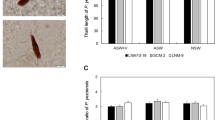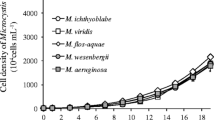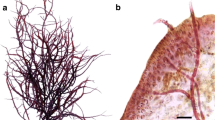Abstract
Morphological characteristics of an edible terrestrial cyanobacteriumNostoc flagelliforme in liquid suspension cultures under photoautotrophic conditions are presented. Different cell forms alternated in a regular manner during the experimentation period (30 d).N. flagelliforme exhibited a very complex life cycle in terms of colony morphology, including mainly 4 different colony morphological forms,viz. hormogonia, filaments, seriate colonies and aseriate colonies. Under laboratory conditions it formed spherical colonies on solid media but not threadlike colonies as it did under natural conditions. The overall life span of the alga was not altered by the existence of different nitrogen sources in the media despite the depression of some cell forms or colony morphologies. Compared with growth on the medium with urea and ammonium as nitrogen sources, the alga on standard medium had a short period of hormogonia and aseriate colony, suggesting that both ammonium and urea could stimulate the formation of hormogonia, at the same time inhibiting the formation of heterocystous cells. The new information on the growth and morphology ofN. flagelliforme could be potentially used for the scale-up or field cultivation.
Similar content being viewed by others
References
Adams D.G.: Heterocyst formation in cyanobacteria.Curr.Opin.Microbiol. 3, 618–624 (2000).
Adams D.G., Duggan P.S.: Heterocyst and akinetes differentiation in cyanobacteria.New Phytol. 144, 3–33 (1999).
Agrawal S.C., Misra U.: Vegetative survival, akinete and zoosporangium formation and germination in some selected algae as affected by nutrients, pH, metals, and pesticides.Folia Microbiol. 47, 527–534 (2002).
Agrawal S.C., Pal U.: Viability of dried vegetative cells or filaments, survivability and/or reproduction under water and light stress, and following heat and UV exposure in some blue-green and green algae.Folia Microbiol. 48, 501–509 (2003).
Agrawal S.C., Singh V.: Vegetative survival, akinete formation and germination in three blue-green algae and one green alga in relation to light intensity, temperature, heat shock and UV exposure.Folia Microbiol. 45, 439–448 (2000).
Agrawal S.C., Singh V.: Viability of dried filaments, survivability and reproduction under water stress, and survivability following heat and UV exposure inLyngbya martensiana, Oscillatoria agardhii, Nostoc calcicola, Hormidium fluitans, Spirogyra sp. andVaucheria geminata.Folia Microbiol. 47, 61–68 (2002).
Anand N., Revathy G.: Reproduction, differentiation and developmental cycles, pp. 31–40 in N. Anand (Ed.):Cyanophyta (Cyanobacteria). Indian Phycological Review. Vol. 2. Bishen Singh Mahendra Pal Singh, Dehra Dun (India) 1993.
Attridge E.M., Rowell P.: Growth, heterocyst differentiation and nitrogenase activity in the cyanobacteriaAnabaena variabilis andAnabaena cylindrica in response to molybdenum and vanadium.New Phytol. 135, 517–526 (1997).
De Philippis R., Vincenzini M.: Exocellular polysaccharides from cyanobacteria and their applications.FEMS Microbiol.Rev. 22, 151–175 (1998).
De Philippis R., Faraloni C., Margheri M.C., Sili C., Herdman M., Vincenzini M.: Morphological and biochemical characterization of the exocellular investments of polysaccharide-producingNostoc strains from the Pasteur Culture Collection.World J.Microbiol.Biotechnol. 16, 655–661 (2000a).
De Philippis R., Ena A., Paperi R., Sili C., Vincenzini M.: Assessment of the potential ofNotsoc strains from the Pasteur Culture Collection for the production of polysaccharides of applied interest.J.Appl.Phycol. 12, 401–407 (2000b).
Gao K.S.: Chinese studies on the edible blue-green alga,Nostoe flagelliforme.J.Appl.Phycol. 10, 37–49 (1998).
Gao K.S., Zou D.H.: Photosynthetic bicarbonate utilization by a terrestrial cyanobacterium,Nostoc flagelliforme (Cyanophyceae).J.Appl.Phycol. 37, 768–771 (2001).
Herdman M.: Akinetes: structure and function, pp. 227–250 in P. Fay, C. Van Baalen (Eds):The Cyanobacteria. Elsevier, Amsterdam (The Nederlands) 1987.
Herdman M.: Cellular differentiation: akinetes, pp. 222–232 in L. Packer, A.Z. Glazer (Eds):Methods in Enzymology, Vol. 167. Academic Press, London 1988.
Huang Z.B., Liu Y.D., Paulsen S.B., Klaveness D.: Studies on polysaccharides from three edible species ofNostoc (Cyanobacteria) with different colony morphologies:comparison of monosaccharide, compositions and viscosities of polysaccharides from field colonies and suspension culture.J.Phycol. 34, 962–968 (1988).
Li S.H.: Ecology of the terrestrial algaNostoc flagelliforme Berk, etCurt, in China.J.Phycol. 27 (Suppl.), 45 (1991).
Li R.H., Watanabe M., Watanabe M.M.: Akinete formation in planktonicAnabaena spp. (Cyanobacteria).J.Phycol. 33, 576–584 (1997).
Nichols J.M., Adams D.G.: Akinetes, pp. 387–412 in N.G. Carr, B.A. Whitton (Eds):The Biology of Cyanobacteria. Blackwell Scientific, Oxford (UK) 1982.
Potts M.: Desiccation tolerance of prokaryotes.Microbiol.Rev. 58, 755–805 (1994).
Potts M.:Nostoc, pp. 465–504 in B.A. Whitton, M. Potts (Eds):The Ecology of Cyanobacteria: Their Diversity in Time and Space. Kluwer Academic Publishers, Dordrecht (The Netherlands) 2000.
Sarma T.A., Khattar J.I.S.: Akinete differentiation in photoheterotrophic and chemoheterotrophic conditions inAnabaena torulosa.Folia Microbiol. 38, 335–340 (1993).
Scherer S., Zhong Z.P.: Desiccation independence of terrestrialNostoc commune ecotypes (Cyanobacteria).Microb.Ecol. 22, 271–283 (1991).
Tseng C.K.: Algal biotechnology industries and research activities in China.J.Appl.Phycol. 13, 375–380 (2001).
Wang M., Xu Y.N., Jiang G.Z., Li L.B., Kuang T.Y.: Membrane lipids and their fatty acid composition inNostoc flagelliforme cells.Acta Bot.Sin. 42, 1263–1266 (2000).
Author information
Authors and Affiliations
Corresponding author
Rights and permissions
About this article
Cite this article
Liu, X.J., Chen, F. Cell differentiation and colony alteration of an edible terrestrial cyanobacteriumNostoc flagelliforme, in liquid suspension cultures. Folia Microbiol 48, 619–626 (2003). https://doi.org/10.1007/BF02993468
Received:
Issue Date:
DOI: https://doi.org/10.1007/BF02993468




